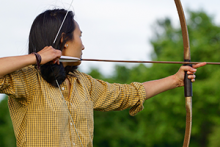Article
A flying projectile shot using a bow, a curved piece of wood held in tension by string, gut, or plastic tied between the two ends. Traditionally, an arrow consists of a straight shaft, made of wood, with a stone “arrow head” projectile point attached on the front. Additionally, the back of the shaft is hafted (indented) and covered with feathers to facilitate the flight and direction of the arrow once it is shot. The bow and arrow are primarily used for hunting and the use of this weapon in the Four Corner’s region began during the end of the Basketmaker time period (A.D. 300-800).
Because of the important advantages that the arrow gave to those peoples who mastered their manufacture and use, the arrow also gained symbolic value. Worked onto the surfaces of ceramics and into textiles and sandpaintings, arrows can represent strength, virility, defense, protection, and courage.
"Woman with bow and arrow," by is licensed under Public Domain.
Manuscripts
References
Reichard, Gladys Amanda
1950 Navaho Religion: A Study of Symbolism. New York: Bollinger Foundation.
Tagg, Martyn D.
1994 Projectile Points of East-Central Arizona: Forms and Chronology. In Middle Little
Colorado River Archeology: From the Parks to the People. Edited by Anne Trinkle Jones
and Martyn D. Tagg. Phoenix: The Arizona Archaeologist.
Wing, Kittridge A.
1955 Bandelier National Monument, New Mexico. National Park Service Historical
Handbook Series No. 20. Washington D.C.: National Park Service.

